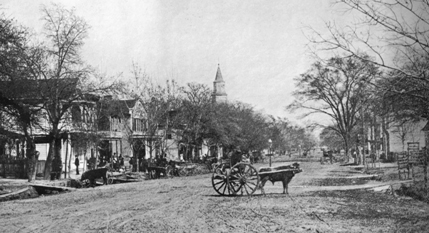Host City
—Northanger Abbey, Chapter 14
Williamsburg, Virginia. From 1699 to 1780, it was the capital city of England’s first and most populous North American colony. Some of the most momentous decisions of the Revolutionary era were made here by some of history’s most storied names. George and Martha Washington knew the city well. Thomas Jefferson, James Monroe, and John Marshall all studied at the College of William & Mary, the only college in North America that can boast a royal charter. Patrick Henry, James Madison, George Wythe, George Mason, and many other well-known statesmen served in the government before and during the Revolution. Both Cornwallis’s British forces and Washington’s Continental Army passed through these streets in the months leading up to their final showdown at Yorktown.
After the capital moved to Richmond in 1780, Williamsburg’s population and prominence slowly declined. Eighty years on, the 1862 Battle of Williamsburg, part of McClellan’s Peninsular Campaign, inflicted its own scars and set the stage for a new drama in the old capital. Because the county line was drawn down the middle of the Duke of Gloucester Street, the Emancipation Proclamation liberated the enslaved population on one side of the road, but not on the other. And a further dividing line also fell at Williamsburg—Union-held territory effectively ended at Boundary Street, and Confederate raiding parties plagued the Federal troops through the end of the war.

Duke of Gloucester (affectionately known as “Dog”) Street before restoration
The gradual transformation of Williamsburg into a sleepy hamlet proved to be a stroke of good fortune in disguise. By the 1920s, when Reverend Goodwin of Bruton Parish Church and John D. Rockefeller Jr. embarked on the project of restoring the town to its eighteenth-century appearance, they found that eighty-eight colonial structures along a mile-long stretch of main road had survived. These were painstakingly restored.
Hundreds of structures that had been lost, including the Governor’s Palace and the House of Burgesses, were reconstructed based on archaeological and documentary evidence. Colonial Williamsburg, the world’s largest living-history museum, opened its doors to the public in 1932 and has been expanded and improved over the succeeding decades.
There are ample modern conveniences, shopping, restaurants, and other commercial structures outside of the Historic Area. Williamsburg even has a major amusement park! However, within the three hundred acres of the colonial city, it is possible to catch a glimpse of the world Jane Austen was born into—a world on the brink not just of one, but of many revolutions. To us, this is history; to her, it was life.

Duke of Gloucester Street today
Other Sites of Interest Nearby
Historic Jamestowne, the site of the first permanent English settlement in North America, now features ongoing archaeological digs and fascinating exhibits in the Archaearium museum. For younger folk, also consider a visit to Jamestown Settlement, where you can see replicas of James Fort and the original colonists’ ships.
Yorktown, the site of the climactic battle of the American Revolution, where you can walk through the town and tour the battlefield. Now also home to the comprehensive American Revolution Museum at Yorktown.
Bacon’s Castle, the only 17th century home still standing in Virginia, played a role in the 1676 rebellion led by Nathaniel Bacon against Virginia’s governor, William Berkeley.
The Mariner’s Museum houses the remains of the Monitor ironclad (of the famous Monitor vs. Merrimack battle) in an engaging, state-of-the-art exhibit. It also features an exhibit on Admiral Lord Nelson and a variety of other offerings spanning the centuries.
Busch Gardens Europe, an amusement park which will be open on the weekend with its Halloween programming.